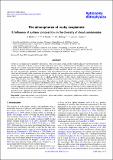The atmospheres of rocky exoplanets : II. Influence of surface composition on the diversity of cloud condensates
Abstract
Clouds are an integral part of planetary atmospheres, with most planets hosting clouds. Understanding not only the formation, but also the composition of clouds, is crucial to understand future observations. As observations of the planet's surface will remain very difficult, it is essential to link the observable high atmosphere gas and cloud composition to the surface conditions. We present a fast and simple chemical equilibrium model for the troposphere of rocky exoplanets, which is in chemical and phase equilibrium with the crust. The hydrostatic equilibrium atmosphere is built from bottom to top. In each atmospheric layer, chemical equilibrium is solved and all thermally stable condensates are removed, depleting the atmosphere above in the effected elements. These removed condensates build an upper limit for cloud formation and can be separated into high and low temperature condensates. The most important cloud condensates for 1000K >∼ Tgas >∼ 400K are KCl[s], NaCl[s], FeS[s], FeS2[s], FeO[s], Fe2O3[s], and Fe3O4[s]. For Tgas ∼< 400K H2O[l,s], C[s], NH3[s], NH4Cl[s], and NH4SH[s] are thermally stable, while for even lower temperatures of Tgas ≤ 150K CO2[s], CH4[s], NH3[s], and H2S[s] become stable. The inclusion of clouds with trace abundances results in the thermal stability of a total of 72 condensates for atmospheres with different surface conditions (300K ≤ Tsurf ≤ 1000K and psurf = 1 bar; 100 bar). The different cloud condensates are not independent of each other, but follow sequences of condensation, which are robust against changes in crust composition, surface pressure, and surface temperature. Independent of the existence of water as a crust condensate, H2O[l,s] is a thermally stable cloud condensate for all investigated elemental abundances. However, the water cloud base depends on the hydration level of the crust. Therefore, the detection of water condensates alone does not necessarily imply stable water on the surface, even if the temperature could allow for water condensation.
Citation
Herbort , O , Woitke , P , Helling , C & Zerkle , A L 2022 , ' The atmospheres of rocky exoplanets : II. Influence of surface composition on the diversity of cloud condensates ' , Astronomy and Astrophysics , vol. 658 , A180 . https://doi.org/10.1051/0004-6361/202141636
Publication
Astronomy and Astrophysics
Status
Peer reviewed
ISSN
0004-6361Type
Journal article
Description
O.H. acknowledges the PhD stipend form the University of St Andrews’ Centre for Exoplanet Science. P.W. and Ch.H. acknowledge funding from the European Union H2020-MSCA-ITN-2019 under Grant Agreement no. 860470 (CHAMELEON).Collections
Items in the St Andrews Research Repository are protected by copyright, with all rights reserved, unless otherwise indicated.
Related items
Showing items related by title, author, creator and subject.
-
Precise masses in the WASP-47 system
Vanderburg, Andrew; Becker, Juliette C.; Buchhave, Lars A.; Mortier, Annelies; Lopez, Eric; Malavolta, Luca; Haywood, Raphaëlle D.; Latham, David W.; Charbonneau, David; López-Morales, Mercedes; Adams, Fred C.; Bonomo, Aldo Stefano; Bouchy, François; Collier Cameron, Andrew; Cosentino, Rosario; Di Fabrizio, Luca; Dumusque, Xavier; Fiorenzano, Aldo; Harutyunyan, Avet; Johnson, John Asher; Lorenzi, Vania; Lovis, Christophe; Mayor, Michel; Micela, Giusi; Molinari, Emilio; Pedani, Marco; Pepe, Francesco; Piotto, Giampaolo; Phillips, David; Rice, Ken; Sasselov, Dimitar; Ségransan, Damien; Sozzetti, Alessandro; Udry, Stéphane; Watson, Chris (2017-11-17) - Journal articleWe present precise radial velocity observations of WASP-47, a star known to host a hot Jupiter, a distant Jovian companion, and, uniquely, two additional transiting planets in short-period orbits: a super-Earth in a ≈19 ... -
Three newly discovered sub-Jupiter-mass planets : WASP-69b and WASP-84b transit active K dwarfs and WASP-70Ab transits the evolved primary of a G4+K3 binary
Anderson, D. R.; Cameron, A. Collier; Delrez, L.; Doyle, A. P.; Faedi, F.; Fumel, A.; Gillon, M.; Chew, Y. Gomez Maqueo; Hellier, C.; Jehin, E.; Lendl, M.; Maxted, P. F. L.; Pepe, F.; Pollacco, D.; Queloz, D.; Segransan, D.; Skillen, I.; Smalley, B.; Smith, A. M. S.; Southworth, J.; Triaud, A. H. M. J.; Turner, O. D.; Udry, S.; West, R. G. (2014-12-01) - Journal articleWe report the discovery of the transiting exoplanets WASP-69b, WASP-70Ab and WASP-84b, each of which orbits a bright star (V ∼ 10). WASP-69b is a bloated Saturn-mass planet (0.26 MJup, 1.06 RJup) in a 3.868-d period around ... -
The well-aligned orbit of Wasp-84b : evidence for disk migration of a hot Jupiter
Anderson, D. R.; Triaud, A. H. M. J.; Turner, O. D.; Brown, D. J. A.; Clark, B. J. M.; Smalley, B.; Cameron, A. Collier; Doyle, A. P.; Gillon, M.; Hellier, C.; Lovis, C.; Maxted, P. F. L.; Pollacco, D.; Queloz, D.; Smith, A. M. S. (2015-02-10) - Journal articleWe report the sky-projected orbital obliquity (spin–orbit angle) of WASP-84 b, a 0.69 planet in an 8.52 day orbit around a G9V/K0V star, to be λ = −0.3 ± 1.7°. We obtain a true obliquity of ψ = 17.3 ± 7.7° from a measurement ...

